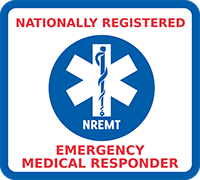Emergency Medical Responder (EMR) Recertification
 Nationally Registered EMRs (NREMR) are required to renew their certification every two (2) years. NREMRs can recertify by either taking the cognitive examination or by completing continuing education. Note: You are encouraged to reference the specific license renewal requirements for every state which you are licensed to practice.
Nationally Registered EMRs (NREMR) are required to renew their certification every two (2) years. NREMRs can recertify by either taking the cognitive examination or by completing continuing education. Note: You are encouraged to reference the specific license renewal requirements for every state which you are licensed to practice.
The EMR National Continued Competency Program (NCCP) requires a total of 16 credits of continuing education to recertify. The model requires continuing education in three components: (1) a national component, (2) a local/state component, and (3) an individual component.
The National Registry accepts State EMS Office accepted and CAPCE accredited education, education from EMS education programs, and U.S. accredited academic credit, college course, or credit provided by the National Registry Alternative Recertification Credits Policy. All education must be directly related to EMS patient care. International providers must complete education from the list of approved United States education sources.
Education can be gathered through online or in-person courses. As of 2022, there are no limits on how much online education you can use on your application.
Courses that cannot be applied towards recertification requirements include duplicate courses, clinical rotations, instructor courses, management/leadership courses, performance of duty, preceptor hours, serving as a skill examiner, and volunteer time with agencies. If you have questions on accepted education, please review the Recertification Guide.
National Component: 8 Credits
NCCP Model requirements have changed. Please check your certification expiration date and choose the correct model for recertification.
- Expiration dates through Sept. 30, 2025: Download the 2016 NCCP Model (PDF)
- The 2025 NCCP Model will begin on April 1, 2025 for EMT/AEMT/Paramedic and October 1, 2025 for EMR: Download the 2025 NCCP Model (PDF)
![]()
Airway/Respiration/Ventilation
- Ventilation
- Oxygenation
![]()
Trauma
- Central Nervous System (CNS) Injury
![]()
Medical
- OB Emergencies
- Infectious Diseases
- Psychiatric and Behavioral Emergencies
- Toxicological Emergencies – Opioids
- Neurological Emergencies – Seizures
- Endocrine Emergencies – Diabetes
- Immunological Emergencies
![]()
Operations
- Field Triage—Disasters/MCIs
- EMS Provider Hygiene, Safety, and Vaccinations
- EMS Culture of Safety
![]()
Cardiovascular
- Post-Resuscitation Care
- Stroke
- Cardiac Arrest
- Pediatric Cardiac Arrest
Local or State Component: 4 Credits
If the agency and/or State EMS Office requires specific education, that education may be entered into this section. If specific education is not specified, these required 4 credits are considered flexible but must be directly related to EMS patient care.Individual Component: 4 Credits
The 4 credits required for the individual component are flexible but must be directly related to EMS patient care.This option enables you to demonstrate continued competency without documenting continuing education.
- Login to your National Registry account. Complete a Recertification by Examination Application and pay the examination fee.
- NOTE: Be sure you complete the Recertification By Examination Application.
- After 24-48 hours, login to your National Registry account and print your Authorization to Test (ATT) letter. Follow the directions in the letter to schedule your examination.
- You may make one attempt to take and pass the examination between October 1 (one year prior to your current expiration date) and September 30 (your expiration date).
Active or Inactive Status
An inactive status is designated for Nationally Registered EMS Clinicians who are currently not providing patient care at their certification level who is not affiliated with an agency, and who cannot obtain skills verification. For example, inactive status may be helpful for EMS professionals who:
- Are not actively engaged in an EMS service or healthcare/patient care activity
- Are not actively treating patients at their certification level but are involved as educators, administrators or regulators
- Are unable to actively provide patient care for any variety of reasons - such as, moving, illness, pursuit of education, family responsibilities, etc.
Inactive status is not for those unable to obtain and meet the educational requirements or those who have had limitations or revocation of a health care license.
EMS clinicians who request inactive status at the EMT level do not need to obtain verification of skills from their Training Officer/Supervisor. These clinicians must complete all refresher and/or, continuing education requirements. These clinicians are eligible to recertify by examination if they so choose.
Returning to Active Status
Nationally Certified EMRs may request a return to active status at any time once they gain active affiliation with an EMS service. A request to return to active status can be sent to your agency’s training officer through your National Registry account or by completing the Inactive to Active form which may be downloaded here.Why Was I Audited?
Reinstatement Information
Lapsed EMR Certification
Responsibilities of Nationally Registered EMS Clinicians
- Change in mailing address (the best way to update a mailing address is by editing the user profile page)
- Disciplinary action taken by any state has resulted in suspension, revocation, or expiration of state registration/licensure; termination of right to practice; voluntary surrender of state registration/licensure while under investigation.
The National Registry considers the individual to be solely responsible for their certification.
Disciplinary Policy and Rights of Appeal
The National Registry has disciplinary procedures, rights of appeal and due process within its policies. Complete information about the National Registry Disciplinary Policy and Rights of Appeal can be found here.
